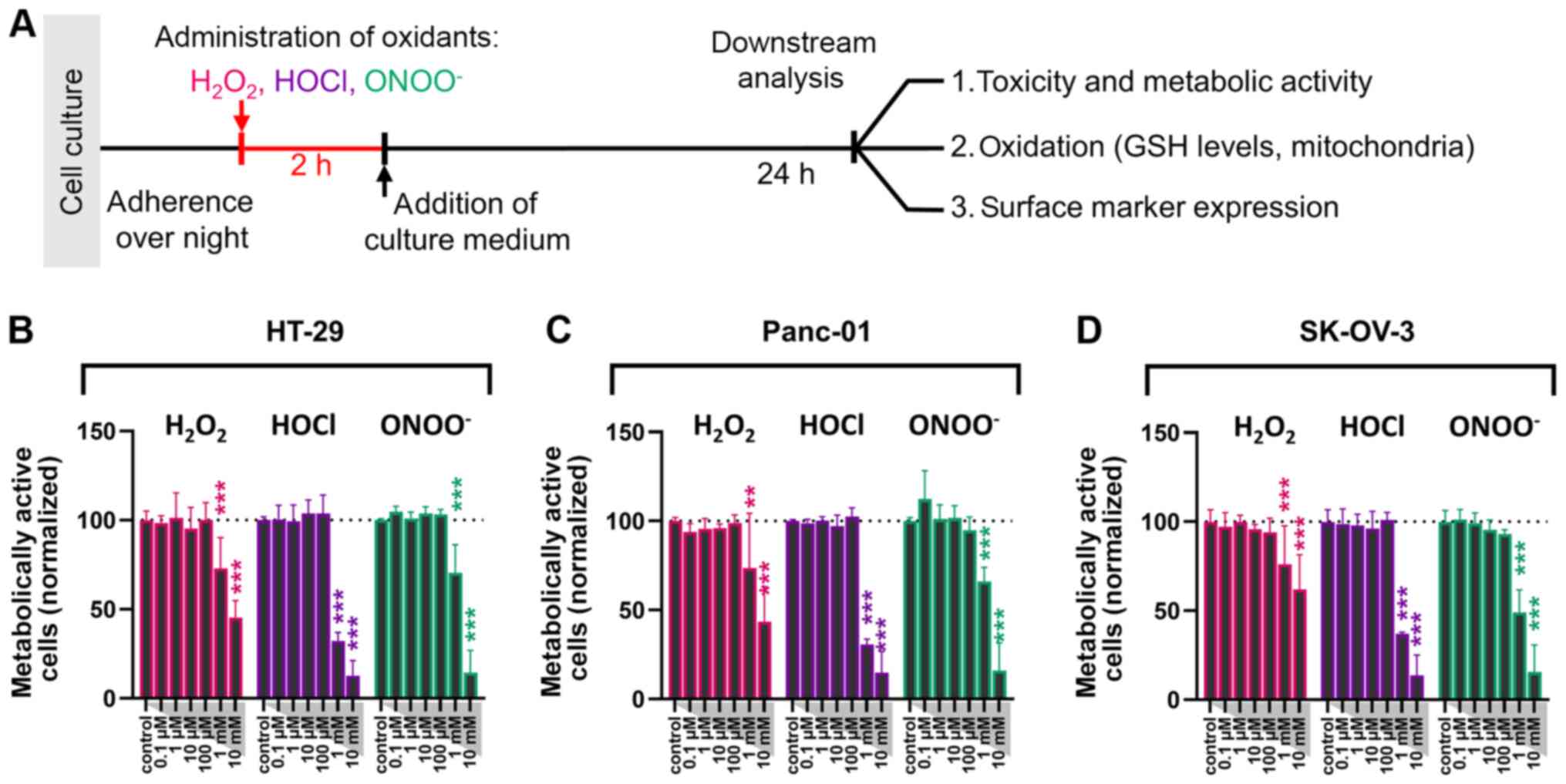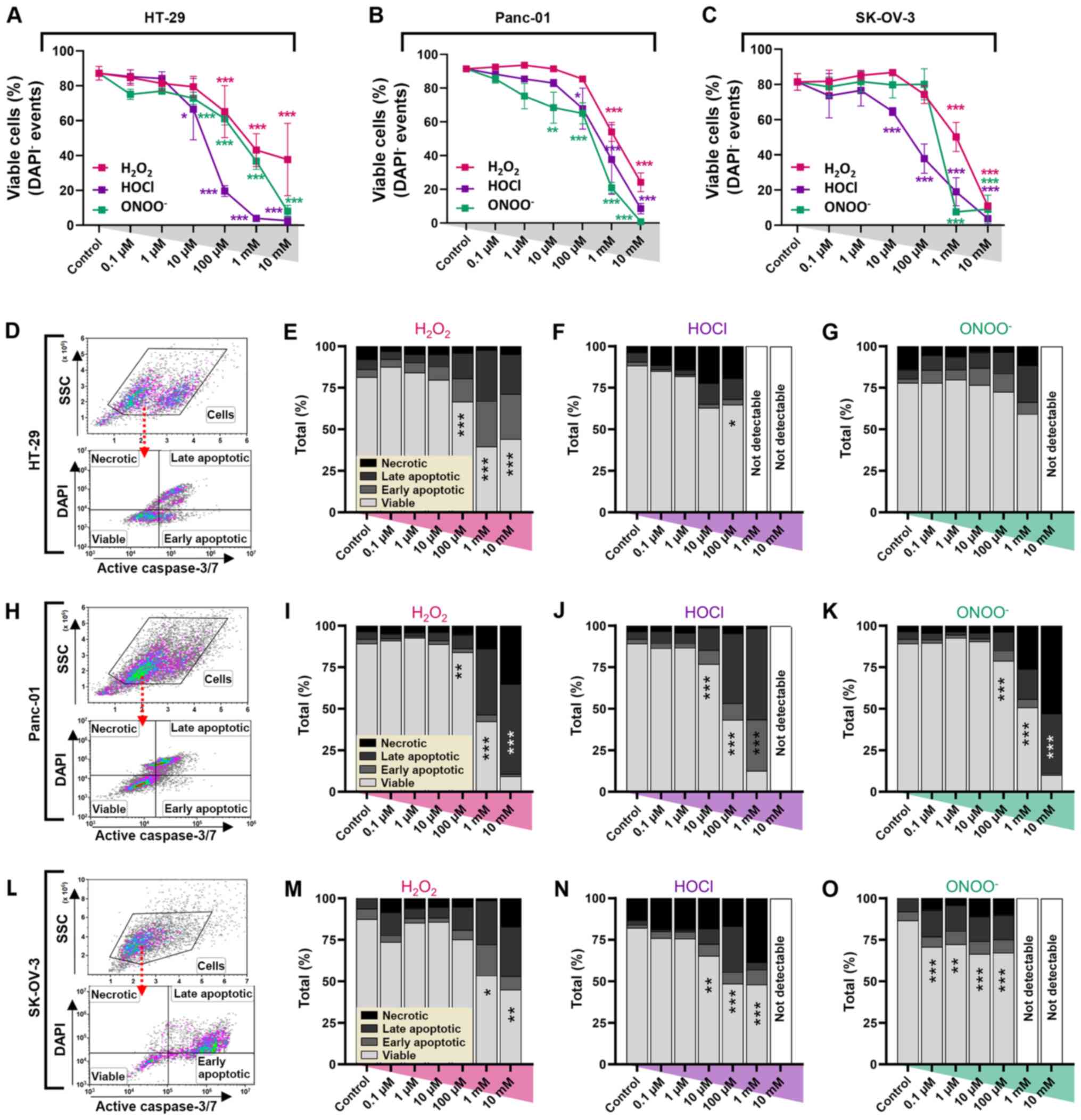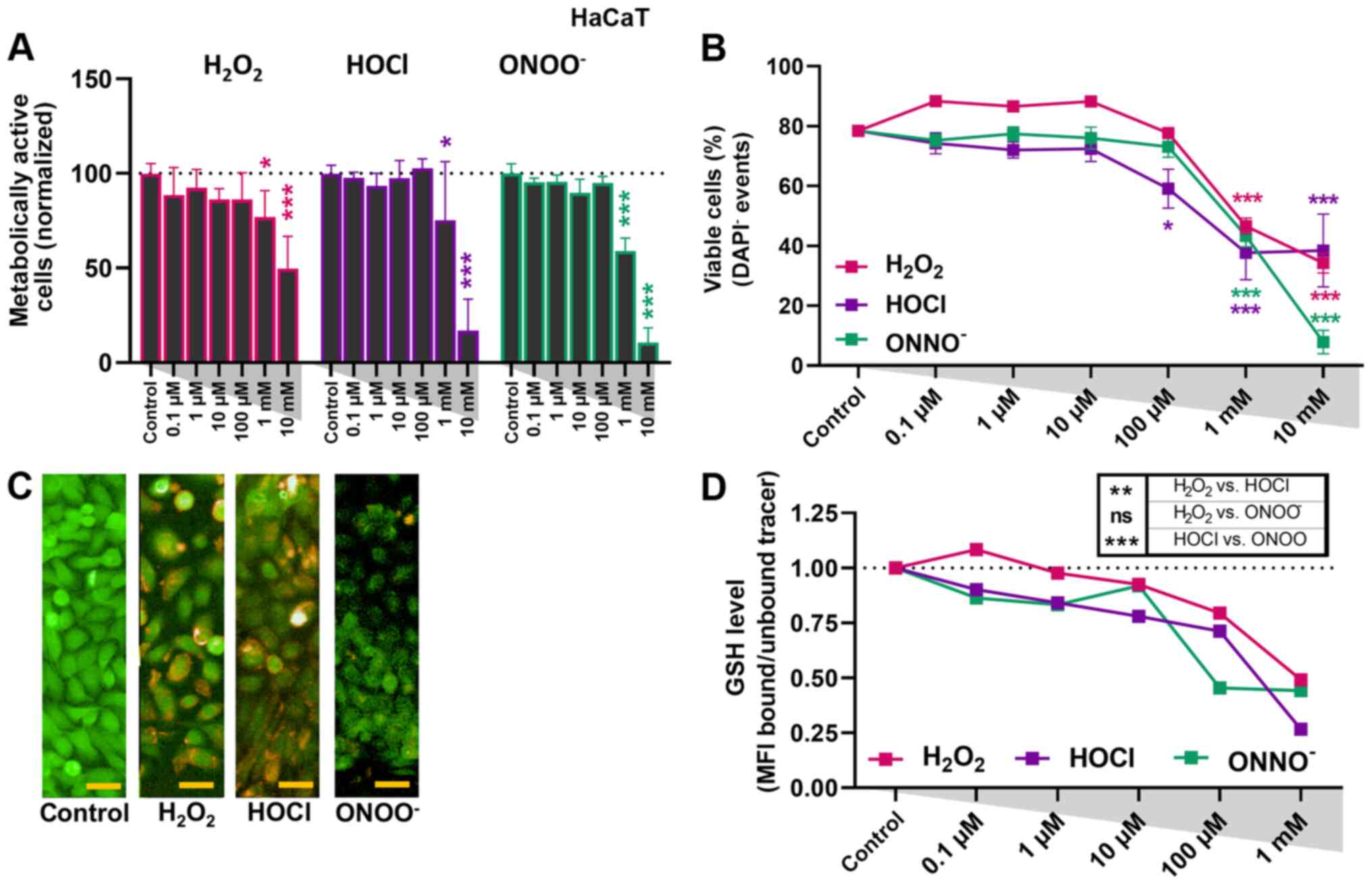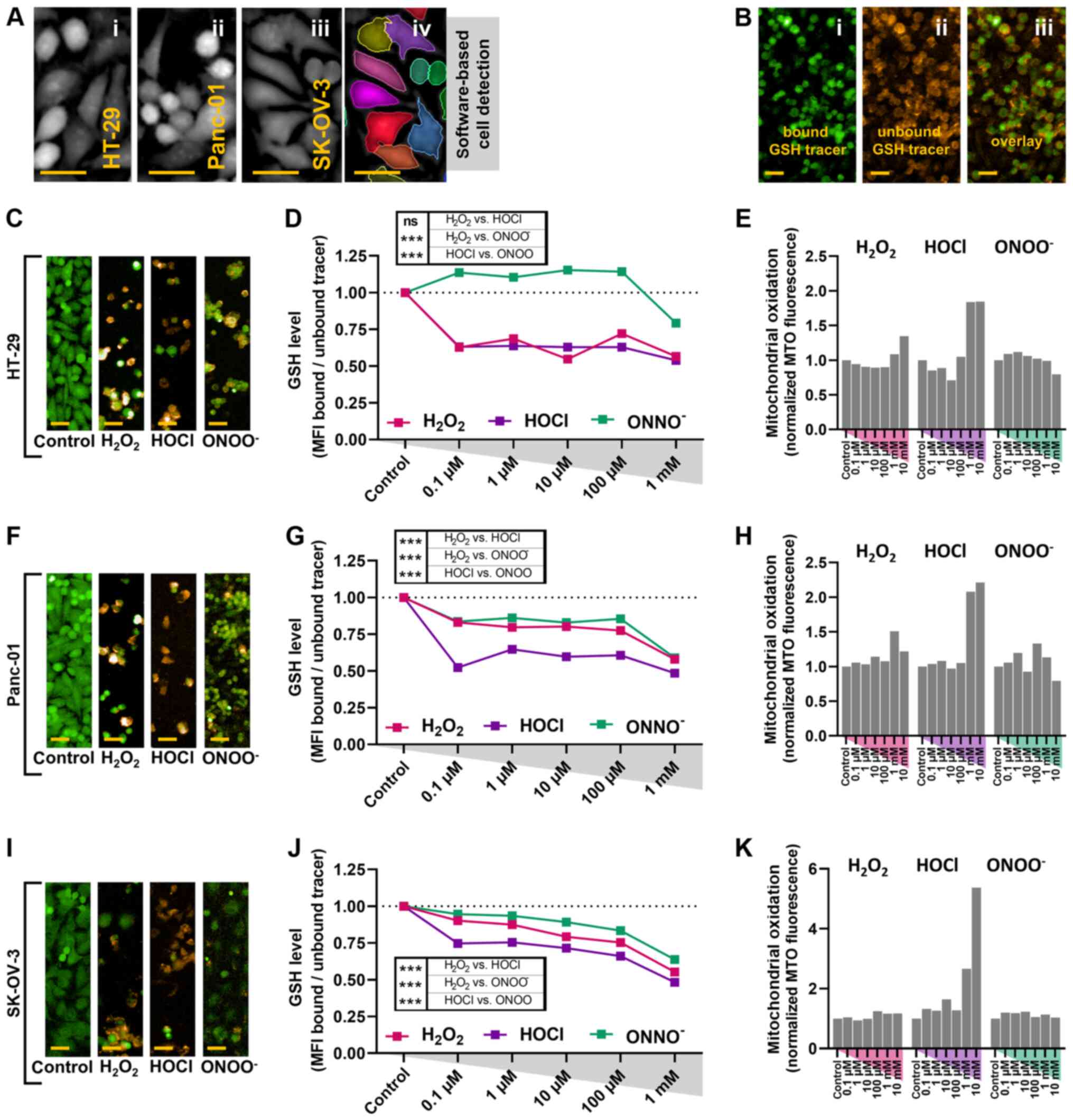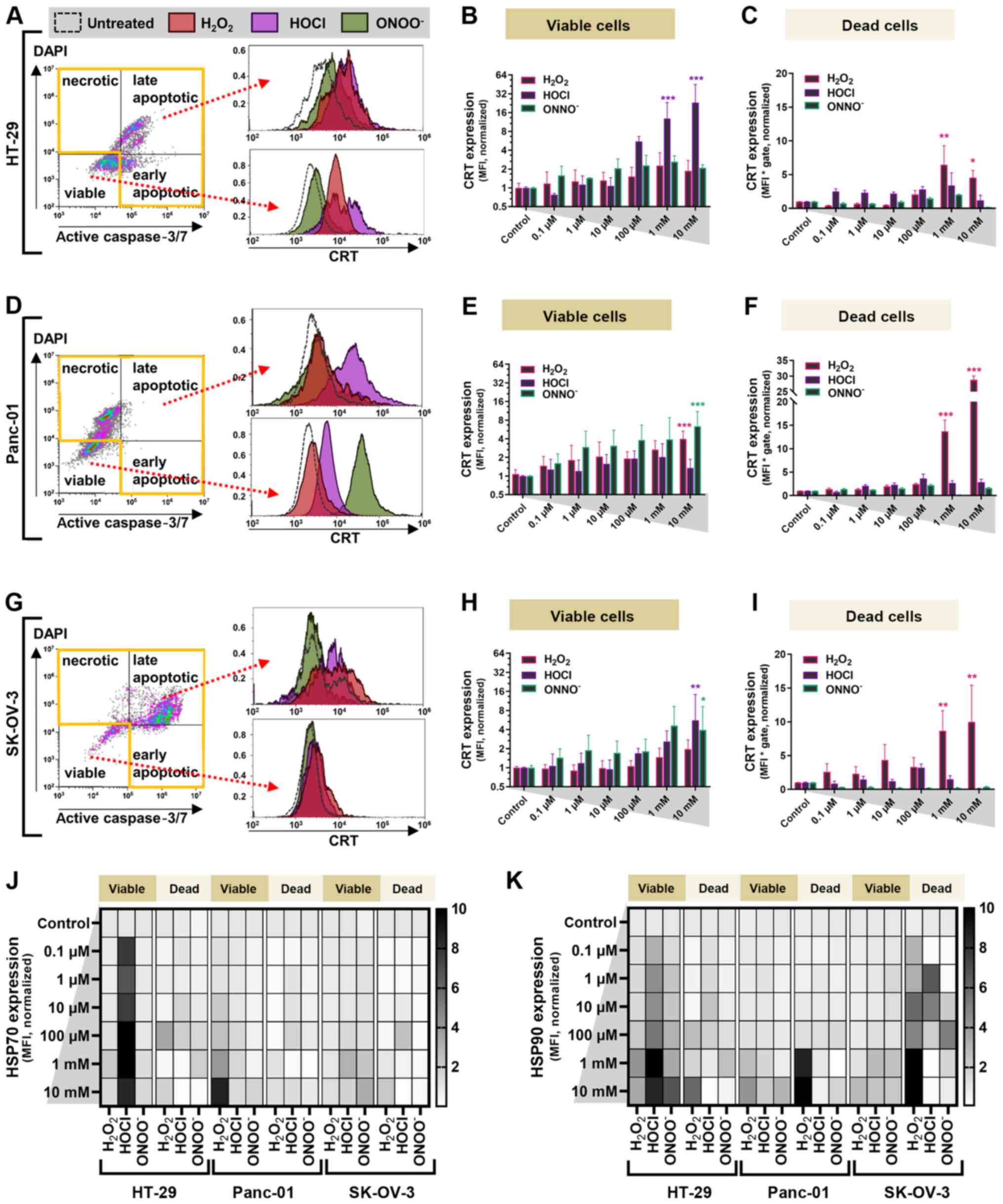|
1
|
Dakwar GR, Shariati M, Willaert W, Ceelen
W, De Smedt SC and Remaut K: Nanomedicine-based intraperitoneal
therapy for the treatment of peritoneal carcinomatosis-mission
possible? Adv Drug Deliv Rev. 108:13–24. 2017. View Article : Google Scholar : PubMed/NCBI
|
|
2
|
Piso P and Arnold D: Multimodal treatment
approaches for peritoneal carcinosis in colorectal cancer. Dtsch
Arztebl Int. 108:802–808. 2011.PubMed/NCBI
|
|
3
|
Oettle H, Neuhaus P, Hochhaus A, Hartmann
JT, Gellert K, Ridwelski K, Niedergethmann M, Zülke C, Fahlke J,
Arning MB, et al: Adjuvant chemotherapy with gemcitabine and
long-term outcomes among patients with resected pancreatic cancer:
The CONKO-001 randomized trial. JAMA. 310:1473–1481. 2013.
View Article : Google Scholar : PubMed/NCBI
|
|
4
|
Esposito I, Kleeff J, Bergmann F, Reiser
C, Herpel E, Friess H, Schirmacher P and Büchler MW: Most
pancreatic cancer resections are R1 resections. Ann Surg Oncol.
15:1651–1660. 2008. View Article : Google Scholar : PubMed/NCBI
|
|
5
|
Shida D, Tsukamoto S, Ochiai H and
Kanemitsu Y: Long-term outcomes after R0 resection of synchronous
peritoneal metastasis from colorectal cancer without cytoreductive
surgery or hyperthermic intraperitoneal chemotherapy. Ann Surg
Oncol. 25:173–178. 2018. View Article : Google Scholar : PubMed/NCBI
|
|
6
|
Tentes AA, Pallas N, Karamveri C,
Kyziridis D and Hristakis C: Cytoreduction and HIPEC for peritoneal
carcinomatosis of pancreatic cancer. J BUON. 23:482–487.
2018.PubMed/NCBI
|
|
7
|
Jayson GC, Kohn EC, Kitchener HC and
Ledermann JA: Ovarian cancer. Lancet. 384:1376–1388. 2014.
View Article : Google Scholar : PubMed/NCBI
|
|
8
|
Pelz JO, Chua TC, Esquivel J, Stojadinovic
A, Doerfer J, Morris DL, Maeder U, Germer CT and Kerscher AG:
Evaluation of best supportive care and systemic chemotherapy as
treatment stratified according to the retrospective peritoneal
surface disease severity score (PSDSS) for peritoneal
carcinomatosis of colorectal origin. BMC Cancer. 10:6892010.
View Article : Google Scholar : PubMed/NCBI
|
|
9
|
Goéré D, Souadka A, Faron M, Cloutier AS,
Viana B, Honoré C, Dumont F and Elias D: Extent of colorectal
peritoneal carcinomatosis: Attempt to define a threshold above
which HIPEC does not offer survival benefit: A comparative study.
Ann Surg Oncol. 22:2958–2964. 2015. View Article : Google Scholar : PubMed/NCBI
|
|
10
|
Solass W, Kerb R, Mürdter T, Giger-Pabst
U, Strumberg D, Tempfer C, Zieren J, Schwab M and Reymond MA:
Intraperitoneal chemotherapy of peritoneal carcinomatosis using
pressurized aerosol as an alternative to liquid solution: First
evidence for efficacy. Ann Surg Oncol. 21:553–559. 2014. View Article : Google Scholar : PubMed/NCBI
|
|
11
|
Pinto A and Pocard M: Photodynamic therapy
and photothermal therapy for the treatment of peritoneal
metastasis: A systematic review. Pleura Peritoneum. 3:201801242018.
View Article : Google Scholar : PubMed/NCBI
|
|
12
|
Farooqi AA, Li KT, Fayyaz S, Chang YT,
Ismail M, Liaw CC, Yuan SS, Tang JY and Chang HW: Anticancer drugs
for the modulation of endoplasmic reticulum stress and oxidative
stress. Tumour Biol. 36:5743–5752. 2015. View Article : Google Scholar : PubMed/NCBI
|
|
13
|
Galadari S, Rahman A, Pallichankandy S and
Thayyullathil F: Reactive oxygen species and cancer paradox: To
promote or to suppress? Free Radic Biol Med. 104:144–164. 2017.
View Article : Google Scholar : PubMed/NCBI
|
|
14
|
Glasauer A and Chandel NS: Targeting
antioxidants for cancer therapy. Biochem Pharmacol. 92:90–101.
2014. View Article : Google Scholar : PubMed/NCBI
|
|
15
|
Gorrini C, Harris IS and Mak TW:
Modulation of oxidative stress as an anticancer strategy. Nat Rev
Drug Discov. 12:931–947. 2013. View Article : Google Scholar : PubMed/NCBI
|
|
16
|
Brigger I, Dubernet C and Couvreur P:
Nanoparticles in cancer therapy and diagnosis. Adv Drug Del Rev.
64:24–36. 2012. View Article : Google Scholar
|
|
17
|
Manshian BB, Poelmans J, Saini S, Pokhrel
S, Grez JJ, Himmelreich U, Mädler L and Soenen SJ:
Nanoparticle-induced inflammation can increase tumor malignancy.
Acta Biomater. 68:99–112. 2018. View Article : Google Scholar : PubMed/NCBI
|
|
18
|
Manke A, Wang L and Rojanasakul Y:
Mechanisms of nanoparticle-induced oxidative stress and toxicity.
Biomed Res Int. 2013:9429162013. View Article : Google Scholar : PubMed/NCBI
|
|
19
|
Hou JT, Wang B, Zhang Y, Cui B, Cao X,
Zhang M, Ye Y and Wang S: Observation of peroxynitrite
overproduction in cells during 5-fluorouracil treatment via a
ratiometric fluorescent probe. Chem Commun (Camb). 56:2759–2762.
2020. View Article : Google Scholar : PubMed/NCBI
|
|
20
|
Kepp O, Menger L, Vacchelli E, Locher C,
Adjemian S, Yamazaki T, Martins I, Sukkurwala AQ, Michaud M,
Senovilla L, et al: Crosstalk between ER stress and immunogenic
cell death. Cytokine Growth Factor Rev. 24:311–318. 2013.
View Article : Google Scholar : PubMed/NCBI
|
|
21
|
Agostinis P, Berg K, Cengel KA, Foster TH,
Girotti AW, Gollnick SO, Hahn SM, Hamblin MR, Juzeniene A, Kessel
D, et al: Photodynamic therapy of cancer: An update. CA Cancer J
Clin. 61:250–281. 2011. View Article : Google Scholar : PubMed/NCBI
|
|
22
|
Garg AD and Agostinis P: ER stress,
autophagy and immunogenic cell death in photodynamic
therapy-induced anti-cancer immune responses. Photochem Photobiol
Sci. 13:474–487. 2014. View Article : Google Scholar : PubMed/NCBI
|
|
23
|
Bekeschus S, Schmidt A, Niessner F,
Gerling T, Weltmann KD and Wende K: Basic research in plasma
medicine-a throughput approach from liquids to cells. J Vis Exp.
563312017.
|
|
24
|
Jablonowski H, Santos Sousa J, Weltmann
KD, Wende K and Reuter S: Quantification of the ozone and singlet
delta oxygen produced in gas and liquid phases by a non-thermal
atmospheric plasma with relevance for medical treatment. Sci Rep.
8:121952018. View Article : Google Scholar : PubMed/NCBI
|
|
25
|
Bekeschus S, Wende K, Hefny MM, Rödder K,
Jablonowski H, Schmidt A, Woedtke TV, Weltmann KD and Benedikt J:
Oxygen atoms are critical in rendering THP-1 leukaemia cells
susceptible to cold physical plasma-induced apoptosis. Sci Rep.
7:27912017. View Article : Google Scholar : PubMed/NCBI
|
|
26
|
Bekeschus S, Clemen R, Nießner F, Sagwal
SK, Freund E and Schmidt A: Medical gas plasma jet technology
targets murine melanoma in an immunogenic fashion. Adv Sci (Weinh).
7:19034382020. View Article : Google Scholar : PubMed/NCBI
|
|
27
|
Lin A, Gorbanev Y, De Backer J, Van
Loenhout J, Van Boxem W, Lemière F, Cos P, Dewilde S, Smits E and
Bogaerts A: Non-thermal plasma as a unique delivery system of
short-lived reactive oxygen and nitrogen species for immunogenic
cell death in melanoma cells. Adv Sci (Weinh). 6:18020622019.
View Article : Google Scholar : PubMed/NCBI
|
|
28
|
Bekeschus S, Clemena R and Metelmann HR:
Potentiating anti-tumor immunity with physical plasma. Clin Plas
Med. 12:17–22. 2018. View Article : Google Scholar
|
|
29
|
Garg AD, Nowis D, Golab J, Vandenabeele P,
Krysko DV and Agostinis P: Immunogenic cell death, DAMPs and
anticancer therapeutics: An emerging amalgamation. Biochim Biophys
Acta. 1805:53–71. 2010.PubMed/NCBI
|
|
30
|
Khalili M, Daniels L, Lin A, Krebs FC,
Snook AE, Bekeschus S, Bowne WB and Miller V: Non-thermal
plasma-induced immunogenic cell death in cancer: A topical review.
J Phys D Appl Phys. 52:4230012019. View Article : Google Scholar : PubMed/NCBI
|
|
31
|
Galluzzi L, Buqué A, Kepp O, Zitvogel L
and Kroemer G: Immunogenic cell death in cancer and infectious
disease. Nat Rev Immunol. 17:97–111. 2017. View Article : Google Scholar : PubMed/NCBI
|
|
32
|
Ledford H, Else H and Warren M: Cancer
immunologists scoop medicine nobel prize. Nature. 562:20–21. 2018.
View Article : Google Scholar : PubMed/NCBI
|
|
33
|
Leebmann H and Piso P: PIPAC and
HIPEC-competing or supplementary therapeutic procedures for
peritoneal metastases. Chirurg. 89:693–698. 2018.(In German).
View Article : Google Scholar : PubMed/NCBI
|
|
34
|
Obeid M, Tesniere A, Ghiringhelli F, Fimia
GM, Apetoh L, Perfettini JL, Castedo M, Mignot G, Panaretakis T,
Casares N, et al: Calreticulin exposure dictates the immunogenicity
of cancer cell death. Nat Med. 13:54–61. 2007. View Article : Google Scholar : PubMed/NCBI
|
|
35
|
Freund E and Bekeschus S: Gas
plasma-oxidized liquids for cancer treatment: Pre-clinical
relevance, immuno-oncology, and clinical obstacles. IEEE Trans
Radiat Plasma Med Sci. 1. 2020. View Article : Google Scholar
|
|
36
|
Kholmukhamedov A, Schwartz JM and
Lemasters JJ: Isolated mitochondria infusion mitigates
ischemia-reperfusion injury of the liver in rats: Mitotracker
probes and mitochondrial membrane potential. Shock. 39:5432013.
View Article : Google Scholar : PubMed/NCBI
|
|
37
|
Freund E, Liedtke KR, van der Linde J,
Metelmann HR, Heidecke CD, Partecke LI and Bekeschus S: Physical
plasma-treated saline promotes an immunogenic phenotype in CT26
colon cancer cells in vitro and in vivo. Sci Rep. 9:6342019.
View Article : Google Scholar : PubMed/NCBI
|
|
38
|
Yamao T, Yamashita YI, Yamamura K, Nakao
Y, Tsukamoto M, Nakagawa S, Okabe H, Hayashi H, Imai K and Baba H:
Cellular senescence, represented by expression of caveolin-1, in
cancer-associated fibroblasts promotes tumor invasion in pancreatic
cancer. Ann Surg Oncol. 26:1552–1559. 2019. View Article : Google Scholar : PubMed/NCBI
|
|
39
|
Waris G and Ahsan H: Reactive oxygen
species: Role in the development of cancer and various chronic
conditions. J Carcinog. 5:142006. View Article : Google Scholar : PubMed/NCBI
|
|
40
|
Valko M, Leibfritz D, Moncol J, Cronin MT,
Mazur M and Telser J: Free radicals and antioxidants in normal
physiological functions and human disease. Int J Biochem Cell Biol.
39:44–84. 2007. View Article : Google Scholar : PubMed/NCBI
|
|
41
|
Zhang J, Wang X, Vikash V, Ye Q, Wu D, Liu
Y and Dong W: ROS and ROS-mediated cellular signaling. Oxid Med
Cell Longev. 2016:43509652016. View Article : Google Scholar : PubMed/NCBI
|
|
42
|
Yu FX and Guan KL: The hippo pathway:
Regulators and regulations. Genes Dev. 27:355–371. 2013. View Article : Google Scholar : PubMed/NCBI
|
|
43
|
Freund E, Liedtke KR, Miebach L, Wende K,
Heidecke A, Kaushik NK, Choi EH, Partecke LI and Bekeschus S:
Identification of two kinase inhibitors with synergistic toxicity
with low-dose hydrogen peroxide in colorectal cancer cells in
vitro. Cancers (Basel). 12:1222020. View Article : Google Scholar
|
|
44
|
Bagheri M, Nair RR, Singh KK and Saini DK:
ATM- ROS-iNOS axis regulates nitric oxide mediated cellular
senescence. Biochim Biophys Acta Mol Cell Res. 1864:177–190. 2017.
View Article : Google Scholar : PubMed/NCBI
|
|
45
|
Acosta JC, Banito A, Wuestefeld T,
Georgilis A, Janich P, Morton JP, Athineos D, Kang TW, Lasitschka
F, Andrulis M, et al: A complex secretory program orchestrated by
the inflammasome controls paracrine senescence. Nat Cell Biol.
15:978–990. 2013. View Article : Google Scholar : PubMed/NCBI
|
|
46
|
Weyemi U, Redon CE, Parekh PR, Dupuy C and
Bonner WM: NADPH oxidases NOXs and DUOXs as putative targets for
cancer therapy. Anticancer Agents Med Chem. 13:502–514. 2013.
View Article : Google Scholar : PubMed/NCBI
|
|
47
|
Bauer G: Central signaling elements of
intercellular reactive oxygen/nitrogen species-dependent induction
of apoptosis in malignant cells. Anticancer Res. 37:499–513. 2017.
View Article : Google Scholar : PubMed/NCBI
|
|
48
|
Navarro-Yepes J, Burns M, Anandhan A,
Khalimonchuk O, del Razo LM, Quintanilla-Vega B, Pappa A,
Panayiotidis MI and Franco R: Oxidative stress, redox signaling,
and autophagy: Cell death versus survival. Antioxid Redox Signal.
21:66–85. 2014. View Article : Google Scholar : PubMed/NCBI
|
|
49
|
Speckmann B, Steinbrenner H, Grune T and
Klotz LO: Peroxynitrite: From interception to signaling. Arch
Biochem Biophys. 595:153–160. 2016. View Article : Google Scholar : PubMed/NCBI
|
|
50
|
Perkins A, Tudorica DA, Amieva MR,
Remington SJ and Guillemin K: Helicobacter pylori senses bleach
(HOCl) as a chemoattractant using a cytosolic chemoreceptor. PLoS
Biol. 17:e30003952019. View Article : Google Scholar : PubMed/NCBI
|
|
51
|
Vandenberk L, Belmans J, Van Woensel M,
Riva M and Van Gool SW: Exploiting the immunogenic potential of
cancer cells for improved dendritic cell vaccines. Front Immunol.
6:6632016. View Article : Google Scholar : PubMed/NCBI
|
|
52
|
Bansal A and Simon MC: Glutathione
metabolism in cancer progression and treatment resistance. J Cell
Biol. 217:2291–2298. 2018. View Article : Google Scholar : PubMed/NCBI
|
|
53
|
Acharya A, Das I, Chandhok D and Saha T:
Redox regulation in cancer: A double-edged sword with therapeutic
potential. Oxid Med Cell Longev. 3:23–34. 2010. View Article : Google Scholar : PubMed/NCBI
|
|
54
|
Balazy M, Kaminski PM, Mao K, Tan J and
Wolin MS: S-nitroglutathione, a product of the reaction between
peroxynitrite and glutathione that generates nitric oxide. J Biol
Chem. 273:32009–32015. 1998. View Article : Google Scholar : PubMed/NCBI
|
|
55
|
Padmaja S, Squadrito GL and Pryor WA:
Inactivation of glutathione peroxidase by peroxynitrite. Arch
Biochem Biophys. 349:1–6. 1998. View Article : Google Scholar : PubMed/NCBI
|
|
56
|
Tesniere A, Apetoh L, Ghiringhelli F, Joza
N, Panaretakis T, Kepp O, Schlemmer F, Zitvogel L and Kroemer G:
Immunogenic cancer cell death: A key-lock paradigm. Curr Opinc
Immunol. 20:504–511. 2008. View Article : Google Scholar
|
|
57
|
Fucikova J, Kasikova L, Truxova I, Laco J,
Skapa P, Ryska A and Spisek R: Relevance of the chaperone-like
protein calreticulin for the biological behavior and clinical
outcome of cancer. Immunol Lett. 193:25–34. 2018. View Article : Google Scholar : PubMed/NCBI
|
|
58
|
Adkins I, Sadilkova L, Hradilova N, Tomala
J, Kovar M and Spisek R: Severe, but not mild heat-shock treatment
induces immunogenic cell death in cancer cells. Oncoimmunology.
6:e13114332017. View Article : Google Scholar : PubMed/NCBI
|
|
59
|
Panaretakis T, Kepp O, Brockmeier U,
Tesniere A, Bjorklund AC, Chapman DC, Durchschlag M, Joza N,
Pierron G, van Endert P, et al: Mechanisms of pre-apoptotic
calreticulin exposure in immunogenic cell death. EMBO J.
28:578–590. 2009. View Article : Google Scholar : PubMed/NCBI
|
|
60
|
Gordon S: The role of the macrophage in
immune regulation. Res Immunol. 149:685–688. 1998. View Article : Google Scholar : PubMed/NCBI
|
|
61
|
Liedtke KR, Freund E, Hackbartha C,
Heideckea CD, Parteckea LI and Bekeschus S: A myeloid and lymphoid
infiltrate in murine pancreatic tumors exposed to plasma-treated
medium. Clin Plas Med. 11:10–17. 2018. View Article : Google Scholar
|
|
62
|
Freund E, Moritz J, Stope M, Seebauer C,
Schmidt A and Bekeschus S: Plasma-derived reactive species shape a
differentiation profile in human monocytes. Appl Sci. 9:25302019.
View Article : Google Scholar
|
|
63
|
Panzarini E, Inguscio V and Dini L:
Immunogenic cell death: Can it be exploited in photodynamic therapy
for cancer? Biomed Res Int. 2013:4821602013. View Article : Google Scholar : PubMed/NCBI
|
|
64
|
Garg AD, Krysko DV, Vandenabeele P and
Agostinis P: Hypericin-based photodynamic therapy induces surface
exposure of damage-associated molecular patterns like HSP70 and
calreticulin. Cancer Immunol Immunother. 61:215–221. 2012.
View Article : Google Scholar : PubMed/NCBI
|
|
65
|
Tcyganov E and Gabrilovich DI:
Peroxynitrite affects MHC I peptide repertoire presented on tumor
cells and impedes the efficacy of antitumor cytotoxic
T-lymphocytes. J Immunol. 202 (Suppl 1):S137.12. 2019.
|
|
66
|
Piskounova E, Agathocleous M, Murphy MM,
Hu Z, Huddlestun SE, Zhao Z, Leitch AM, Johnson TM, DeBerardinis RJ
and Morrison SJ: Oxidative stress inhibits distant metastasis by
human melanoma cells. Nature. 527:186–191. 2015. View Article : Google Scholar : PubMed/NCBI
|
|
67
|
Palmer LJ, Cooper PR, Ling MR, Wright HJ,
Huissoon A and Chapple IL: Hypochlorous acid regulates neutrophil
extracellular trap release in humans. Clin Exp Immunol.
167:261–268. 2012. View Article : Google Scholar : PubMed/NCBI
|
|
68
|
Prokopowicz ZM, Arce F, Biedroń R, Chiang
CL, Ciszek M, Katz DR, Nowakowska M, Zapotoczny S, Marcinkiewicz J
and Chain BM: Hypochlorous acid: A natural adjuvant that
facilitates antigen processing, cross-priming, and the induction of
adaptive immunity. J Immunol. 184:824–835. 2010. View Article : Google Scholar : PubMed/NCBI
|
|
69
|
Zhou R, Huang WJ, Ma C, Zhou Y, Yao YQ,
Wang YX, Gou LT, Yi C and Yang JL: HOCl oxidation-modified CT26
cell vaccine inhibits colon tumor growth in a mouse model. Asian
Pac J Cancer Prev. 13:4037–4043. 2012. View Article : Google Scholar : PubMed/NCBI
|
|
70
|
Chiang CL, Kandalaft LE, Tanyi J, Hagemann
AR, Motz GT, Svoronos N, Montone K, Mantia-Smaldone GM, Smith L,
Nisenbaum HL, et al: A dendritic cell vaccine pulsed with
autologous hypochlorous acid-oxidized ovarian cancer lysate primes
effective broad antitumor immunity: From bench to bedside. Clin
Cancer Res. 19:4801–4815. 2013. View Article : Google Scholar : PubMed/NCBI
|
|
71
|
Tanyi JL, Bobisse S, Ophir E, Tuyaerts S,
Roberti A, Genolet R, Baumgartner P, Stevenson BJ, Iseli C, Dangaj
D, et al: Personalized cancer vaccine effectively mobilizes
antitumor T cell immunity in ovarian cancer. Sci Transl Med.
10:eaao59312018. View Article : Google Scholar : PubMed/NCBI
|















